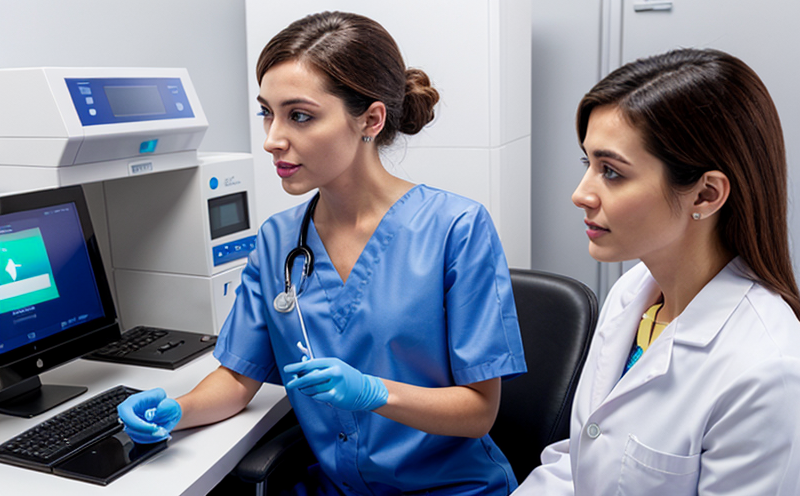Molecular Detection of Legionella pneumophila in Cooling Towers
The molecular detection of Legionella pneumophila is a critical process within the clinical and healthcare testing sector, particularly focusing on the safety and hygiene of water systems used in facilities such as hospitals, hotels, and office buildings. Legionella bacteria are opportunistic pathogens that can cause severe respiratory infections known as Legionnaires' disease, which has a mortality rate of up to 30% if not treated promptly. Cooling towers, often found in HVAC (Heating, Ventilation, and Air Conditioning) systems, provide an ideal environment for the growth of Legionella pneumophila. This bacteria thrives in warm, stagnant water with high nutrient levels, which is precisely what cooling towers offer.
The use of molecular detection methods has revolutionized the way we identify Legionella pneumophila. Traditional culturing techniques are time-consuming and often miss low-level contamination. Molecular assays, on the other hand, allow for rapid identification with high sensitivity and specificity. Polymerase Chain Reaction (PCR) is widely used in this context, as it can amplify specific DNA sequences of Legionella pneumophila, enabling precise detection even at trace levels.
The process begins with water sampling from the cooling tower system. Proper specimen preparation involves filtering the sample to concentrate potential pathogens and then performing a nucleic acid extraction procedure using appropriate reagents. This step is crucial for ensuring that the DNA of Legionella pneumophila can be accurately detected in subsequent PCR reactions.
The molecular detection process itself typically follows these steps:
- DNA Extraction: Utilizes column-based or bead-based methods to isolate genomic material from the sample.
- PCR Amplification: Uses primers specific for Legionella pneumophila DNA, which are designed based on internationally recognized standards such as ISO 12910-3. The PCR reaction is optimized to ensure high sensitivity and specificity.
- Detection: The amplified product can be detected using agarose gel electrophoresis or real-time PCR techniques, both of which provide clear visual evidence of the presence of Legionella pneumophila.
- Confirmation: Positive samples are further analyzed to determine the strain type and antibiotic resistance profile.
The results of this molecular detection are typically reported in terms of colony-forming units per liter (cfu/L) or simply as a binary result indicating presence or absence. This information is vital for facility managers to take appropriate action, such as disinfection or system modifications, to prevent the spread of Legionnaires' disease.
Applied Standards
The molecular detection of Legionella pneumophila in cooling towers follows several internationally recognized standards that ensure both accuracy and consistency across different laboratories. The most commonly referenced standard is ISO 12910-3, which provides guidelines for the sampling and analysis of Legionella from building water systems.
This standard emphasizes the importance of standardized procedures to prevent contamination during sample collection and processing. It also specifies the use of appropriate reagents and equipment to ensure reliable PCR results. Additionally, EN ISO 21789-3:2015, which is a European standard for Legionella sampling in building water systems, provides supplementary guidance on sample preparation techniques.
Compliance with these standards ensures that the molecular detection process adheres to high-quality laboratory practices and aligns with global health regulations. This compliance is essential not only for maintaining the integrity of test results but also for ensuring that facilities meet legal requirements regarding public health safety.
Industry Applications
- Hospital Hygiene: Ensuring the water systems in hospitals are free from Legionella pneumophila is critical to preventing outbreaks of Legionnaires' disease among patients and staff.
- Hotel & Resort Maintenance: Hotels frequently use cooling towers for efficient air conditioning, making regular testing essential to safeguard guest health.
- Office Building Management: Large office buildings often have extensive HVAC systems that require routine monitoring to ensure they do not become breeding grounds for Legionella bacteria.
- Data Center Operations: High-efficiency cooling towers in data centers are subject to strict hygiene protocols due to their critical role in maintaining optimal operating temperatures.
The molecular detection of Legionella pneumophila is particularly important for facilities that have complex HVAC systems, as these provide an ideal environment for bacterial growth. Regular testing and the implementation of preventive measures can significantly reduce the risk of Legionnaires' disease outbreaks in such settings.
Why Choose This Test
- Rapid Results: Molecular detection methods offer faster results compared to traditional culturing techniques, allowing for quicker response times and intervention measures.
- High Sensitivity & Specificity: PCR-based assays can detect Legionella pneumophila at very low concentrations, ensuring that even small outbreaks are identified early.
- Precision & Reliability: The use of internationally recognized standards guarantees consistent and accurate results across different laboratories.
- Cost-Effective: While initial setup costs may be high, the long-term benefits in terms of reduced healthcare expenses and increased facility safety make this a cost-effective choice for many organizations.
The molecular detection of Legionella pneumophila is not only a critical tool for maintaining public health but also an essential component of any facility's comprehensive hygiene strategy. By leveraging advanced molecular techniques, healthcare facilities can ensure that their water systems remain safe and hygienic.





